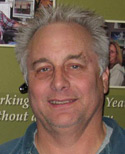Kerry Ewald retires after 33 years
 |
| Kerry Ewald |
Kerry Ewald will bid good-bye today to Fermilab’s design and drafting group in the Technical Division, but he’s not leaving the world of particle physics.
After 33 years of working on components for Fermilab’s Tevatron and R&D for the next-generation linear collider cavities, he’ll take his skills to the world's most intense pulsed accelerator-based neutron source, the Spallation Neutron Source at Oak Ridge National Laboratory in Tennessee.
Ewald says that he will miss Fermilab’s worldly environment as well as many of the people he has worked with here. “I’ve met a lot of people from a lot of places in the world,” he said. “You get to learn much from people in this type of environment.”
The 56-year-old designer started working at Fermilab in 1976 as a machine shop assistant, moving up the ranks as he learned more engineering skills.
He has worked on several projects, including magnet design for the LHC and ILC, but his favorite project was the end-plug upgrade for CDF. “ We worked out of lab 5 in the village, designing, building, and testing the east and west end plugs. It was a time for me when I did everything from design to fabrication to installation. It was a team of people who worked together.”
Ewald looks forward to the challenges of a new job.
“Plus I love the country there. I bought a log cabin on 37 acres in the mountains. I’ll get to drive Harley and drive my Miata through the mountains,” he said. “I'll finally have my own land to hunt deer on.”
Wish Ewald well at his retirement party today from 1:30 p.m. to 3:30 p.m. in trailer 157.
--Kristine Crane
|